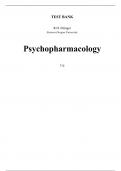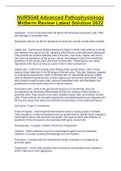Exam (elaborations)
TEST BANK R.H. Ettinger Eastern Oregon University Psychopharmacology
- Course
- Institution
CHAPTER 1 ORGANIZATION AND FUNCTION OF THE NERVOUS SYSTEM 1.1 Multiple Choice 1. The average human brain contains nearly ________ neurons. a. 10 billion b. 100 billion c. 200 billion d. 1 trillion Answer: C Diff: 1 Page Ref: 1 2. The three major classes of neurons are a. motor, se...
[Show more]




